 I’m at the W Hotel in San Francisco to hear Xiaomi President Lin Bin and VP Hugo Barra give their pitch to Silicon Valley.
I’m at the W Hotel in San Francisco to hear Xiaomi President Lin Bin and VP Hugo Barra give their pitch to Silicon Valley.We’ve been told we sho
uldn’t expect an announcement of the company bringing its products to the US, so the impression we’ve gotten is that this is about explaining what Xiaomi really does.
Why does it need to do that, you ask?
Along with not getting the actual segment Xiaomi is going for, most people in the Valley understand that Xiaomi wants to build services atop its devices, but probably couldn’t tell you what those services are. Xiaomi will likely clear up that confusion for Western techies during its presentation today.
No set time for US mi.com launch. Hugo Barra says it will happen when it’s ready.
Lin Bin continues to respond that it has to do with market size
(aiming for low smartphone penetration with high growth), popularity of
e-commerce.
Journalist after journalist asking slightly different variations of
“are patents preventing you from launching phones in the United
States?”
Still, Xiaomi’s fitness trackers, power packs, headphones are all
really nice for way less than what most US consumers are used to. Those
products should do really well here.
Hugo Barra just confirmed Xiaomi phones and tablets aren’t coming to the US later this year.
In Q/A session, Lin Bin says “we never share info on our margins.”
Sounds like everything but their phones/tablets might come here this year.
Both Xiaomi appliances and third-party devices are managed from a single app in MIUI.
Now we’re talking about Xiaomi’s vision for the smart home.
MIUI is “easy to understand, but impossible to master” because there are so many hidden features.
There are more than 5,000 themes available for MIUI. Users have
downloaded them more than 2 billion times. Doesn’t just add a skin on
top of MIUI — themes can add games or apps to the lock screen, for
example.
MIUI has built-in features for getting train/movie tickets, hailing a ride, making bank/doctor appointments.
MIUI users can label an incoming call as spam by tapping a button,
if enough people do it all MIUI users will see the number as spam.
Now we’re actually talking about Internet services Xiaomi offers.
Hugo Barra is showing how the MIUI interface’s animations have
consistent physics — even rain in the weather app changes direction to
still fall “down” when you hold the phone at different angles.
The multitasking feature looks a lot like iOS. But there’s one
difference that’s interesting for power users: you can swipe up to
dismiss an app, or down to force MIUI to keep the app in memory so the
OS won’t lose your place/data when it’s in the background.
You can bulk delete apps from you home screen in MIUI.
Hugo is comparing app management on the home screen between MIUI
and iOS. When he has trouble moving between pages in iOS, he speculates
about turning off the animation in a setting. “No, it looks like you
have to live through it.”
MIUI gives you the option to record a phone call starting at any point in a conversation.
While MIUI comes with Xiaomi’s phones, it supports 347 models on 96 brands. “These are users who download our ROM and flash their own devices.”
Hugo Barra speaking now. He says MIUI is not a fork of Android, but a layer of software and services on top of it.
Xiaomi also employs 2,765 call center workers, with support available 24/7.
On Tmall Single’s Day (November 11th), Xiaomi had monster sales last year. They sold 1.1 million phones…
They’re playing a fan’s Chinese rap video about Xiaomi phones and the beat is kind of sick.
On screen: “Creatives REALLY matter”
Lin Bin details Xiaomi’s history of being the first to use well-known mobile chipsets in China. “And we were close to being first to use the Snapdragon 810.” He sounds genuinely disappointed.
There are 40 million active members on Xiaomi’s Mi Forum. 169,000 daily posts.
Lin bin says Xiaomi has sent out 224 of its weekly updates to MIUI.
Going into Xiaomi’s MIUI layer on top of Android. Originally
launched to ~100 users in August 2010, now has more than 100 million
users.
“We are an Internet company. We do more than make phones.”
5 out of 8 of the most-activated Android phones in China are Xiaomi.
#1 smartphone manufacturer in China according to IHS, #3 e-commerce company in the country.
Jumped right into the business. In 2014, 61.1 million Xiaomi phones sold, 227% growth.
Hugo Barra’s new Chinese name is “Tiger Brother.”
Lin Bin talking about Xiaomi’s name. Translation is literally “little rice,” but “Mi” also stands for “mobile internet.”
We all just filed in. This room isn’t as big as I expected.

























Lin Bin and Hugo Barra just wrapped Q/A. Now we get to go play with devices.